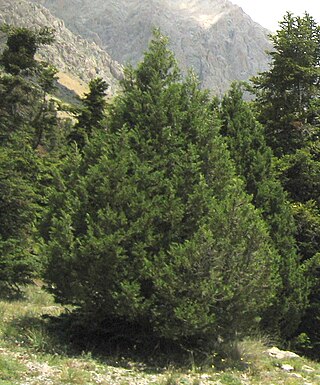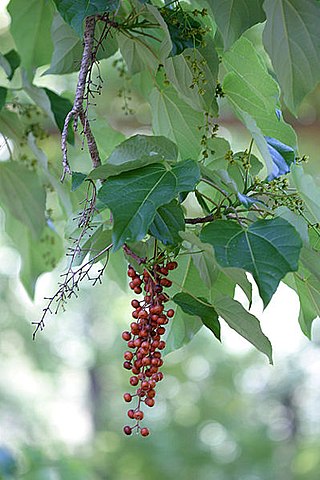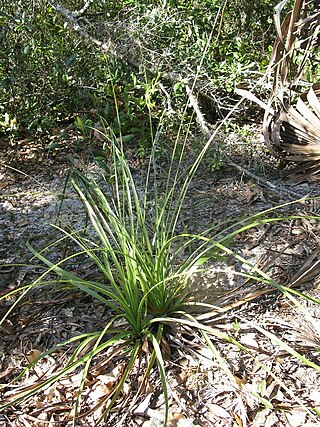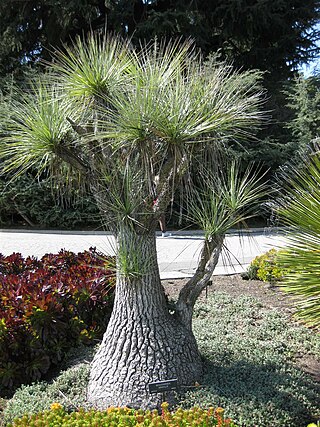
Nolina is a genus of tropical xerophytic flowering plants, with the principal distribution being in Mexico and extending into the southern United States. They are large, dioecious plants.

Glyptostrobus pensilis, known in Chinese as 水松, and also Chinese swamp cypress, is an endangered conifer, and the sole living species in the genus Glyptostrobus.

Juniperus excelsa, commonly called the Greek juniper, is a juniper found throughout the eastern Mediterranean, from northeastern Greece and southern Bulgaria across Turkey to Syria and Lebanon, Jordan, the Caucasus mountains, and southern coast of Crimea.

Borassus is a genus of five species of fan palms, native to tropical regions of Africa, Asia, and Papua New Guinea.

Nolina parryi is a flowering plant that is native to Baja California, southern California and Arizona.

Beaucarnea is a genus of flowering plants native to Mexico and Central America. In the APG III classification system, it is placed in the family Asparagaceae, subfamily Nolinoideae. Beaucarnea is sometimes treated as a synonym of the genus Nolina, with the species being then transferred to that genus. However, recent research shows that Beaucarnea should be treated as an independent genus.

Juniperus foetidissima, with common names foetid juniper or stinking juniper, is a juniper tree species in the family Cupressaceae.

Angophora costata, commonly known as Sydney red gum, rusty gum or smooth-barked apple, is a species of tree that is endemic to eastern Australia. Reaching 30 m (100 ft) in height, the species has distinctive smooth bark that is pinkish or orange-brown when new and fades to grey with age. Its lance-shaped leaves are arranged in opposite pairs along the stems, with white or creamy white flowers appearing from October to December. The flower buds are usually arranged in groups of three, followed by ribbed, oval or bell-shaped fruit.

Idesia is a genus of flowering plants in the family Salicaceae, comprising the single species Idesia polycarpa. It is native to eastern Asia in China, Japan, Korea, and Taiwan.

Nolina bigelovii is a flowering plant native to the Southwestern United States, California, and northwest Mexico. It grows in the driest desert areas and at elevations up to 1,500 metres (4,900 ft).

Nolina interrata is a rare species of flowering plant known by the common names Dehesa nolina and Dehesa beargrass. It is known from about ten occurrences in central San Diego County, California, and fewer than 100 individual plants on land across the border in Baja California. The plant was first described in 1946 when found at the type locality near El Cajon, California, and all the individuals known in California are located within a six-square-mile area there. Although rare, numbering about 9,000 plants total in existence, the species is relatively well protected in its habitat and a proposal for federal protected status was withdrawn.

Nolina brittoniana is a rare species of flowering plant in the asparagus family known by the common name Britton's beargrass. It is endemic to Florida, where there are 72 known populations, only a few of which are large enough to be considered viable. It is federally listed as an endangered species of the United States.

Nolina microcarpa is a species of flowering plant in the asparagus family known by the common names sacahuista and palmilla. Like other species of Nolina, it may be called beargrass. It is native to northern Mexico and the southwestern United States in Arizona and New Mexico. It does occur in the southwestern corner of Utah, where it has a limited distribution on Navajo Sandstone, but reports of it occurring in Texas may be in error.

Dasylirion leiophyllum is a species of flowering plant in the asparagus family known by the common names green sotol, smooth-leaf sotol, and smooth sotol. It is native to North America, where it occurs in Chihuahua and Coahuila in Mexico and New Mexico and western Texas in the United States. It was first collected by Valery Havard in 1880 and was described by William Trelease in 1911.

Beaucarnea gracilis is an attractive member of the subfamily Nolinaceae of the family Asparagaceae native to partial-desert areas in Mexico. Its name "gracilis", meaning "slender", is misleading, as its trunk is especially bulbous. It was formerly known as Nolina gracilis.

Nolina greenei, woodland beargrass, is a plant species native to the United States. It is widespread in New Mexico and also reported from Colorado, Texas and Oklahoma.

Corymbia collina, commonly known as silver-leaved bloodwood, is a species of tree that is endemic to Western Australia. It has thin patchy rough bark on some or all of the trunk, smooth white to pale grey bark above, lance-shaped to curved adult leaves, flower buds in groups of seven, creamy white flowers and barrel-shaped fruit.

Dracophyllum arboreum, commonly known as Chatham Island grass tree and tarahinau (Moriori), is a species of tree in the heath family Ericaceae. Endemic to the Chatham Islands of New Zealand, it reaches a height of 18 m (60 ft) and has leaves that differ between the juvenile and adult forms.

Nolina beldingii is a species of perennial flowering plant in the family Asparagaceae known commonly as the Cape nolina or Belding's beargrass. It is an arborescent monocot growing up to 7 metres (23 ft) high, with fissured bark on a trunk topped with leaf rosettes. The narrow leaves are up to 1.15 m (3.8 ft) long, and are used as thatching by local peoples. This species is endemic to Baja California Sur in Mexico, where it grows only in the highest reaches of the Sierra de la Laguna. It is found primarily in oak forests at elevations over 1,000 m (3,300 ft) along rocky granite outcrops.

Nolina texana, the Texas sacahuiste or Texas beargrass, is a plant in the asparagus family that resembles a large clump of grass. It grows in the south central United States and Northern Mexico. They are sometimes grown as a garden plant in xeriscape or native plant gardens.




















